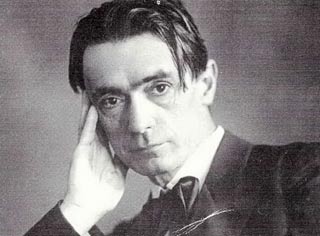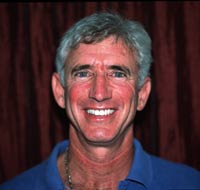|
TennisOne Lessons How to Go From Good to Great Jack Broudy There is a particular body motion in almost every sport or physical activity that a gifted athlete performs intuitively. They know it by feel. People call these players "natural athletes" or, in the case of tennis, they call him Roger Federer. But this specific body motion goes completely unseen by those of us watching. Even many coaches, trainers, and instructors can’t identify it. But the athletes’ entire body is engaged in the most efficient, fluid, and seamless flow of motion, resulting in what appears to be effortless power, control, and grace. This unseen dynamic motion and balance is what makes the greatest athletes stand out from the rest.
However, this unique motion is not exclusive to top athletes. It can be learned by virtually anyone. And it can be seen in all graceful or natural motion — from a dancer or martial artist, to a waving flag, or a cracking whip. In fact, even a baby uses this same motion to roll over, or when learning to crawl. Inspired by the works of 20th century scientist and mathematician Rudolf Steiner, it became apparent to me, as a coach of high ranking players, that this particular motion is the ‘mother-form’ of all natural movement, and in particular all ‘natural’ athletes. I also realized, it can be learned by anyone. Dynamic Motion So, let’s take a look at what this dynamic motion is all about. Whether throwing or kicking a ball, swinging a bat, a racquet, or a golf club, most good athletes know that a tremendous amount of speed and power can be generated without ever having to move their arms or legs. They do it through simple core-body rotation, which in turn creates coordinated centrifugal force and inertia. This works much the way an Olympic athlete throws a discus, or like the way Jimmy Connors used to hit his groundstrokes, locking his arms and rotating his body in a semi-circle. The power and swing is initiated from the core. Just as a record on a record player moves exponentially faster at the outer rim as compared to the inner, or a water-skier at the end of a tow-rope can go much faster than the boat, so can an athlete generate power and speed just by rotating his body, hips, and shoulders — while their arms or legs remain relatively relaxed. However, the ‘gifted’ or ‘natural’ athlete, whether they realize it or not, rotates their core quite differently from a ‘good’ athlete, thus causing a noticeably different motion throughout the entire body. Which, in turn, also causes them to move their arms and legs differently as well. Unlike the simple semi-circle hip or core rotation, the exceptional athlete rotates his hips in a slow, yet continuous figure 8 path — an infinity sign. This motion causes the arms and legs to be pulled, creating a coil effect that is continuously expanding, and intensifying in energy, from the body’s core out to the apex of the throw, the hit, or even a kick. This dynamic motion of the body, arms and/or legs is similar to that of a bullwhip, continuously and rapidly gaining speed. And when you consider that while the hand may only be traveling at 30-40 mph, the tip of the whip is actually breaking the sound barrier at over 600 mph, you will be well on your way to understanding how top athletes generate the speed and power they do. You are starting to understand ‘dynamic balance’ and the geometric principles of ‘non-linear motion.’ Whether it’s throwing or hitting a baseball, hitting a tennis forehand, backhand or serve, or even driving a golf ball, this same non-linear motion can be seen in every one of these movements. And it’s the same motion that can and will enhance any athletes’ performance.‘ A Tale of Two Forehands
As this pertains to tennis specifically, let’s look at the real difference between the forehands of both Andy Roddick and Roger Federer. It is obvious that while Andy’s forehand stroke is good, Federer’s is a level up, and great. Andy’s forehand stroke consists of a big, wide swing that is relatively the same speed throughout, whereas Federer’s stroke is much smaller and slower in the beginning, with all the speed happening at contact. And no matter how fast Roddick swings at the ball he cannot produce the same racquet head speed as Roger. Perhaps, unbeknownst to both players, Federer uses the slow, continuous, “whip-like” motion initiated from his hips, whereas Roddick simply swings fast (more by strength and will, primarily from his upper body) in a semi-circle type path. The difference between their forehands is in the geometry of the strokes, and it is tantamount to what separates the two players — good from great. To put it as simply as possible, just think of this non-linear motion as a figure-8, or the infinity symbol. And think of it on both a horizontal and vertical plane. Now, think of that figure-8 motion as the ‘engine’ or source of energy that creates centrifugal force and a resulting sine wave emanating out from it, in concentric waves. With very little investigation, you’ll find that this ‘figure-8’ motion, or a variant of it, is actually at the core, and is the mother-form, of all types of natural movement and motion. In fact, it can be found throughout natural science — starting with the analemma of the earth. If you do a little research and look up the lemniscates of Bernoulli and Gerono. Then look up the Cassini oval, the Watt's curve, or the harmonics of the Lissajous or Bowditch curve, I think you’ll quickly see what we’re referring to. Now, go back and look closer at the effortless form of a top tennis pro like Roger Federer, Novak Djokovic, Rafael Nadal, or Andre Agassi. And in particular, watch the motion and rotation of their hips and core — on every one of their strokes. Still not convinced?
This same figure-8 motion, done properly, and in one continuous motion, will elevate any person's level of performance in any sport. And any person can learn it. You don't have to be a so-called natural athlete. I’ll say it again. ANY person can elevate their performance in ANY sport by simply learning to do the figure-8 properly. That may seem like a bold statement to make, but the figure-8 is the entry point to an all-encompassing form of movement. It provides more balance, more power and effortless control. It takes the centrifugal force of a simple pivot to the next level. And it ties everything together in one fluid motion. One of the keys to the figure-8 is a slow, continuous movement, starting in the hips and emanating out to the entire body. This, in turn, furls and unravels the arms and/or legs in a non-linear fashion, producing immense speed and power, with complete control — all with very little effort. Another key is that this motion is equally represented in both the horizontal and vertical axis, left and right sides, and concentrically moves through the entire body like a human sine wave, connecting everything into one motion. I can’t stress enough that everything becomes connected with this single motion. Fully understanding this will lead you deeper into what the best athletes do so naturally. People have become one-side dominant, linear thinkers, but the non-linear figure-8 can free them to perform beyond their personal limitations. It is a complete connection that will synchronize the entire body. And in our next article we will get into exactly how that’s done. How to unlock the power of the figure-8. So how is it done — this figure-8? Most of us need some help when it comes to learning and engraining this figure-8 motion in our bodies. The 8 Board is a great training device that can help create the feel of this figure-8 motion.
Begin by first adjusting the 8 Board to the proper height, which is, for most sports, hips to shoulders width apart: for baseball slightly wider, for skiing slightly narrower. Place the 8 Board on the flat ground, be it a tennis court, golf driving range or on your living room floor. Then carefully, holding onto something if necessary, stand with your two feet in the center of the two swivels. Start with the proper posture, standing in a neutral position “zero point”: facing forward with your hands in front of you, feet parallel to one another shoulders width apart, toes forward, back straight, eyes looking straight ahead, knees very slightly bent. You should feel relaxed and balanced before you begin. Now clasp your hands together, all except the thumbs and index fingers, which form a “pointer” by pressing them together, index fingers now pointing the same direction as your toes. To complete this initial stage, attach your two elbows to your sides (ribs), locking your arms and fingers, creating a triangle, with your chest completing the form(far left diagram). Now move the two swivels of the 8 Board from side to side, slowly. Focus on moving continuously with balance and comfort. Now, it is imperative to remember two things. 1. Keep your elbows attached to your hips. This assures that your feet and hips move with the movement of your fingers. And 2. As you come from “zero point” (which is the center point of the infinity sign, or the “X” directly in front of you) make sure that you rise into each turn. So you rise into each turn coming from your center, and then fall as you round the corner. Now you should be moving your entire body, like a moving statue in this continuous infinity sign, or sideways figure-8 path of motion, driven by your index fingers. You’ll notice as your hands swing from side to side in this continuous motion that your weight will alternately shift slightly from one foot to the other. Simultaneously you’ll begin to feel the muscles in your abdomen working to bend and straighten while your body twists and straightens throughout the movement. This feeling of a “natural throwing motion” once learned, can be applied to every sport’s motion, from hitting a tennis or golf ball to the spinning of a figure skater. Watch a short-stop in baseball in action. He catches and throws all in one fluid and continuous motion, as natural as a fish in water. All sports, activities and general well-being can be enhanced by understanding how the entire body interacts as a “human web”, whereby when one part of the body moves, every part of the body moves, in relationship. Once a person develops this balanced fluidity through practice, it becomes “muscle memory” and applicable to sports, and especially tennis. The concept of a continuous figure-8 motion is simple, yet far-reaching. The figure-8 body motion itself is also simple, though it takes some practice. So instead of “loading up” or trying to gain racquet head speed by merely swinging faster, try relaxing your hands and upper body, and let your hips generate the fluid natural power of Roger Federer. Allow the figure-8 and the “science of the wave” to bring your game from good to great.
Your comments are welcome. Let us know what you think about Jack Broudy's article by emailing us here at TennisOne.
Broudy has recently completed the first patented, complete and "closed" tennis teaching method, based on physics. His next goal is to challenge the minds of pros and players to understand that the natural tennis strokes can be duplicated, by anyone if they have a clear understanding of the geometric theories inherent in them. Broudy has unlocked the mystery of the natural strokes in tennis, through a science called projective geometry. Check out the 8-Board Here: If this thinking strikes a chord in you please feel free to visit www.SchoolOfTennis.Net or email Jack at jack@SchoolOfTennis.Net or follow him on Facebook. |

